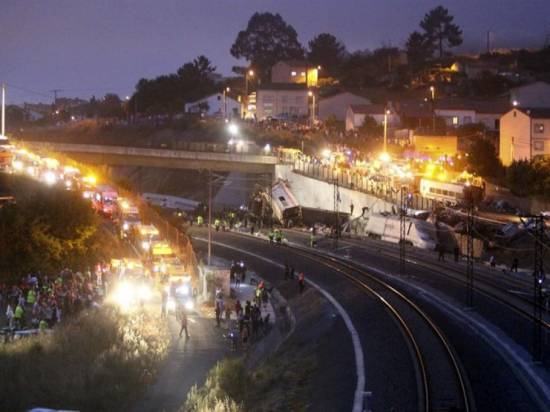Sunday July 28, almost four days from the Galician train tragedy, on the eve of the festivity of St. James, only four kilometers away from the station of Santiago (St. James) de Compostela, the city named after the Apostle, whose remains are buried in the Cathedral.

A date when hundreds of thousands of pilgrims from all over the world gather in the place where the historical and international ‘Way of St. James’ ends, at the foot of the Apostle.
Four days after the tragedy, the wagons and locomotive are no longer dispersed around the outskirts of Angrois village , they are under custody in a nearby police warehouse and the railway line is open again. 79 dead, 31 critical injured, all those many families under shock. Dead and injured from all over Spain, European and American countries. The train that day was full because on the eve of St. James, people arrive to Santiago walking, by car, train, bus, plane, bicycle, motorcycle…any.
What happened? According to the different parties, the previous circumstantial evidence is shared by the engine driver and possible misunderstandings in the security control system. Investigation is under way, and speculations (many) apart, there’s one fact: The driver was a usual one in the line, over sixty times in the last two months, but that night he entered a curve signalled 80 kms./hour at 190 kms./hour! Why? When the ‘black box’ is investigated plus all the research work already done by scientific police and Renfe experts, the real reasons and responsibilities will be cleared out. So far only too many, why?, unbearable sorrow and perplexity.

An official funeral will be held this Monday July 29 in Santiago’s Catedral. Home funerals have already taken place in different Spanish cities, and they will be summing up in the following days. The whole country is particularly grateful to the earliest volunteers, people from Angrois village, police, firemen, ambulances, hospitals, medical teams, psicologists trained in grand catasthrophes, and so many others. Testimonies from victim’s families, survivors, injured and miraculously unharmed. Many were going to celebrate in Santiago the events of the day, some were expected for a wedding, a baptism, one shows his pilgrim book all stamped, only missing the final stamp in Santiago, the seven year old boy who ‘had lost his yellow dinosaur’, found and returned to him to his great joy and many more we’ll know about in coming days.
This is a sorrow that leaves a deep print, even not being a victim. It is a sorrow that makes history, a real tragedy, because nobody returns from death, probably an evitable death. Before this, all other news are unimportant, this is the kind of human tragedy that is important by itself, even if Media weren’t there, other things only have the importance attributed by the Media and little else.
It is a tragedy that leads to think about fatality, particularly in Galicia, land of ghosts (Santa Compaña) and ‘meigas’ (witches). Why an experienced professional locomotive driver who knows by heart the peculiarities of that line, does something unthinkable precisely on that particular day, the eve of Saint James?



